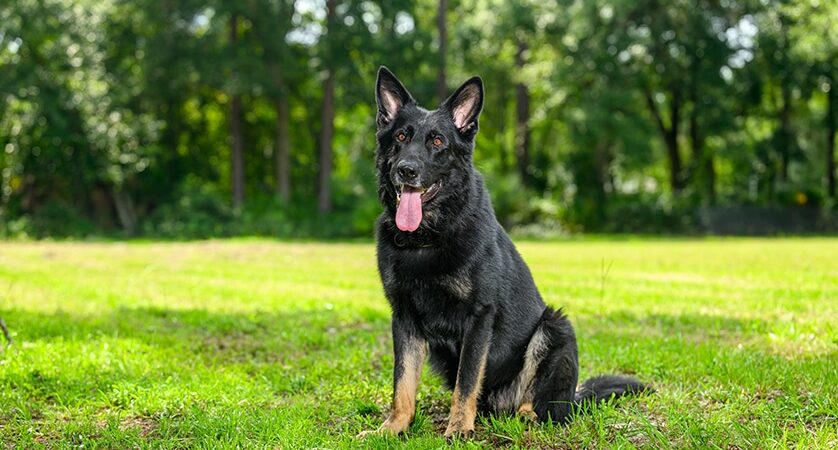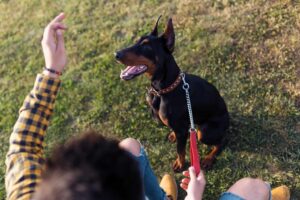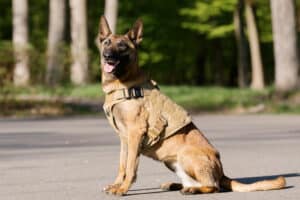






Protecting priceless treasures like those at the Art Institute? Yeah, that’s no easy job.
Yet, between 1922 and 1940, a remarkable team of German Shepherds took on this challenge with unwavering loyalty and skill.
It all began in 1922 when a regal purebred named Prince arrived, soon joined by his female counterpart, Peggy, in 1925.
To test their abilities, an ingenious test was devised. A volunteer was instructed to hide themselves within a large chest in one of the galleries.
Released into the museum, the dogs’ keen senses quickly led them to the hidden individual. They circled the room persistently until recalled—much to the relief of the one in hiding.
Their competence proven, Prince and Peggy became regular members of the museum’s nightly patrols. Alongside their human counterparts, they covered five miles each night, from 9:00 PM to 6:00 AM.
But their story is just one chapter in a much longer history of protection dogs.
These loyal animals have been guarding people and possessions since ancient times, evolving from simple watchdogs to highly trained security companions.
The bond between humans and dogs goes back thousands of years, and over time, these incredible animals have adapted to new challenges and threats.
Now, let’s walk you through the rich history of protection dogs: from ancient times to modern security.
Back then, dogs were primarily used to guard livestock and homes.
Ancient Egyptians, for instance, used large dogs like the Saluki and Pharaoh Hound to protect their herds and households.
These dogs were known for their loyalty and bravery, qualities that still define protection dogs today.
Similarly, in ancient Greece and Rome, dogs served as guards for homes, temples, and military camps.
Molossian dogs—ancestors of modern breeds like the Mastiff—were often employed to protect against intruders and wild animals.
These early protection dogs didn’t have the formal training we see today, but their instincts to defend their territory and humans made them invaluable.

Large, powerful breeds like the Mastiff and Great Dane were used by knights and soldiers to protect camps and engage in battle.
These dogs were often outfitted with armor and sent to attack enemies, making them an integral part of medieval warfare.
At the same time, dogs continued to serve as loyal protectors of property. Castles, farms, and estates often relied on dogs to warn of intruders or to protect livestock.
Their keen senses made them far more effective than early human guards, who could easily miss a hidden threat.
Dogs, on the other hand, could smell and hear intruders from a great distance, making them the perfect security system.
It wasn’t until the 19th century that the formal training of protection dogs became more common.
In Europe, particularly in Germany, dog breeds like the German Shepherd were developed specifically for protection and work.
Max von Stephanitz, often credited with founding the modern German Shepherd breed, believed in the importance of creating a versatile working dog.
German Shepherds quickly became known for their intelligence, strength, and protective instincts, making them ideal for both police and military work.
During this time, other breeds also gained popularity for protection work.
Rottweilers, originally used for herding cattle, were recognized for their ability to guard property and became widely used by butchers and farmers.
Doberman Pinschers, developed by a German tax collector named Louis Dobermann, were bred specifically for personal protection, known for their speed, agility, and loyalty.

The two World Wars played a significant role in advancing the skills and deployment of these canine guardians.
When the U.S. entered World War II, the Army didn’t have a plan to use dogs. However, dog owners, breeders, and a few military leaders saw their potential, especially after the attack on Pearl
Harbor, and formed Dogs for Defense in 1942.
Supported by the American Kennel Club, they trained dogs to guard industrial plants and military sites.
Despite challenges, the program grew, eventually transferring to the Army’s Remount Branch, which expanded its reach.
Initially, over 30 dog breeds were considered for military service, but by 1944, the list was narrowed to seven key breeds like German Shepherds and Doberman Pinschers, which proved best suited for sentry duty.
The dogs were used for various tasks including sentry duty, detecting mines, and delivering messages under fire.
Post-war advancements in dog training techniques led to more specialized roles for protection dogs.
Police forces around the world began incorporating K-9 units, using dogs for tasks such as tracking suspects, detecting narcotics, and providing backup in dangerous situations.
The Belgian Malinois, for instance, gained popularity in law enforcement due to its high energy, intelligence, and trainability.
Private security firms also began to recognize the value of protection dogs.
In the late 20th and early 21st centuries, protection dogs faced new challenges.
The rapid rise of technology-based security systems, like surveillance cameras and alarm systems, led some to question the ongoing relevance of canine protectors.
After all, why rely on dogs when technology could provide 24/7 monitoring without rest?
However, dogs quickly proved their adaptability and value. While tech-based systems could detect intruders or alert authorities, they couldn’t physically deter threats or engage in real-time protection.
Dogs brought active defense that no machine could replicate. Their ability to sense danger, react instinctively, and provide immediate physical response became crucial in situations where seconds mattered.
As security needs evolved, so did the training of these dogs.
They were no longer just guards for homes or property; many began receiving specialized training for roles such as bomb detection, drug-sniffing, and search-and-rescue missions.
Their natural abilities, paired with advanced training methods, allowed them to excel in environments where both physical security and high-level detection were necessary.
Dogs began working alongside law enforcement and military personnel, assisting in operations that required more than technology could offer.

As cybersecurity grows and digital threats dominate headlines, people are recognizing the importance of balancing tech-based security with physical protection.
High net-worth individuals, and celebrities like athletes, actors, and business moguls are investing in elite protection dogs as part of their personal security teams.
And this goes beyond having a guard dog in the traditional sense—it’s about having a trustworthy companion who is trained to protect, detect threats, and deter potential harm.
In short, they give you some peace of mind.
But this trend isn’t exclusive to the rich and famous. More families now see the value in having a protection dog around the house especially with the world becoming increasingly unpredictable.
What’s even better is that today’s protection dogs are trained to fit seamlessly into family life.
You’ll find that these dogs are incredibly loyal, great with kids, and affectionate, but they can switch into protection mode in a heartbeat if necessary.
As you can see…
…protection dogs have come full circle—from ancient guardians of livestock and homes to modern-day security partners, proving their adaptability and enduring value in an ever-changing world.
Whether serving alongside soldiers on the front lines or providing peace of mind to families at home, these dogs continue to demonstrate their indispensable role in keeping people and property safe.
Now, it’s your turn…
…to experience ELITE protection, loyalty, companionship and some peace of mind. All from Vanguard Protection Dogs.
Our expertly trained dogs are life-changing companions that redefine what it means to feel safe.
And here’s a deal for you:
🐾Premium protection dog
🐾Personalized training program
🐾Lifetime support and consultation
Contact Vanguard Protection Dogs today and find the right protection dog for your needs.
Your safety deserves the best. Let us help you achieve that.